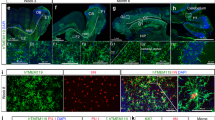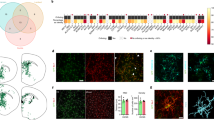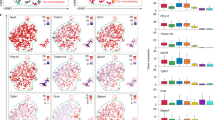Abstract
Microgliosis is a common response to multiple types of damage in the CNS. However, the origin of the cells involved in this process is still controversial and the relative importance of local expansion versus recruitment of microglia progenitors from the bloodstream is unclear. Here, we investigated the origin of microglia using chimeric animals obtained by parabiosis. We found no evidence of microglia progenitor recruitment from the circulation in denervation or CNS neurodegenerative disease, suggesting that maintenance and local expansion of microglia are solely dependent on the self-renewal of CNS resident cells in these models.
This is a preview of subscription content, access via your institution
Access options
Subscribe to this journal
Receive 12 print issues and online access
$209.00 per year
only $17.42 per issue
Buy this article
- Purchase on Springer Link
- Instant access to full article PDF
Prices may be subject to local taxes which are calculated during checkout




Similar content being viewed by others
References
Kreutzberg, G.W. Microglia: a sensor for pathological events in the CNS. Trends Neurosci. 19, 312–318 (1996).
Nimmerjahn, A., Kirchhoff, F. & Helmchen, F. Resting microglial cells are highly dynamic surveillants of brain parenchyma in vivo. Science 308, 1314–1318 (2005).
Davalos, D. et al. ATP mediates rapid microglial response to local brain injury in vivo. Nat. Neurosci. 8, 752–758 (2005).
Jensen, M.B., Gonzalez, B., Castellano, B. & Zimmer, J. Microglial and astroglial reactions to anterograde axonal degeneration: a histochemical and immunocytochemical study of the adult rat fascia dentata after entorhinal perforant path lesions. Exp. Brain Res. 98, 245–260 (1994).
Lehrmann, E., Christensen, T., Zimmer, J., Diemer, N.H. & Finsen, B. Microglial and macrophage reactions mark progressive changes and define the penumbra in the rat neocortex and striatum after transient middle cerebral artery occlusion. J. Comp. Neurol. 386, 461–476 (1997).
Gonzalez-Scarano, F. & Baltuch, G. Microglia as mediators of inflammatory and degenerative diseases. Annu. Rev. Neurosci. 22, 219–240 (1999).
Ponomarev, E.D., Shriver, L.P., Maresz, K. & Dittel, B.N. Microglial cell activation and proliferation precedes the onset of CNS autoimmunity. J. Neurosci. Res. 81, 374–389 (2005).
McGeer, P.L. et al. Microglia in degenerative neurological disease. Glia 7, 84–92 (1993).
Hess, D.C. et al. Hematopoietic origin of microglial and perivascular cells in brain. Exp. Neurol. 186, 134–144 (2004).
Biffi, A. et al. Correction of metachromatic leukodystrophy in the mouse model by transplantation of genetically modified hematopoietic stem cells. J. Clin. Invest. 113, 1118–1129 (2004).
Simard, A.R. & Rivest, S. Bone marrow stem cells have the ability to populate the entire central nervous system into fully differentiated parenchymal microglia. FASEB J. 18, 998–1000 (2004).
Priller, J. et al. Targeting gene-modified hematopoietic cells to the central nervous system: use of green fluorescent protein uncovers microglial engraftment. Nat. Med. 7, 1356–1361 (2001).
Kennedy, D.W. & Abkowitz, J.L. Kinetics of central nervous system microglial and macrophage engraftment: analysis using a transgenic bone marrow transplantation model. Blood 90, 986–993 (1997).
Flugel, A., Bradl, M., Kreutzberg, G.W. & Graeber, M.B. Transformation of donor-derived bone marrow precursors into host microglia during autoimmune CNS inflammation and during the retrograde response to axotomy. J. Neurosci. Res. 66, 74–82 (2001).
Krall, W.J., Challita, P.M., Perlmutter, L.S., Skelton, D.C. & Kohn, D.B. Cells expressing human glucocerebrosidase from a retroviral vector repopulate macrophages and central nervous system microglia after murine bone marrow transplantation. Blood 83, 2737–2748 (1994).
Asheuer, M. et al. Human CD34+ cells differentiate into microglia and express recombinant therapeutic protein. Proc. Natl. Acad. Sci. USA 101, 3557–3562 (2004).
Hickey, W.F., Vass, K. & Lassmann, H. Bone marrow–derived elements in the central nervous system: an immunohistochemical and ultrastructural survey of rat chimeras. J. Neuropathol. Exp. Neurol. 51, 246–256 (1992).
Hickey, W.F. & Kimura, H. Perivascular microglial cells of the CNS are bone marrow–derived and present antigen in vivo. Science 239, 290–292 (1988).
Massengale, M., Wagers, A.J., Vogel, H. & Weissman, I.L. Hematopoietic cells maintain hematopoietic fates upon entering the brain. J. Exp. Med. 201, 1579–1589 (2005).
Graeber, M.B., Tetzlaff, W., Streit, W.J. & Kreutzberg, G.W. Microglial cells, but not astrocytes, undergo mitosis following rat facial nerve axotomy. Neurosci. Lett. 85, 317–321 (1988).
Solomon, J.N. et al. Origin and distribution of bone marrow–derived cells in the central nervous system in a mouse model of amyotrophic lateral sclerosis. Glia 53, 744–753 (2006).
Li, Y.Q., Chen, P., Jain, V., Reilly, R.M. & Wong, C.S. Early radiation-induced endothelial cell loss and blood-spinal cord barrier breakdown in the rat spinal cord. Radiat. Res. 161, 143–152 (2004).
Diserbo, M. et al. Blood-brain barrier permeability after gamma whole-body irradiation: an in vivo microdialysis study. Can. J. Physiol. Pharmacol. 80, 670–678 (2002).
Rossi, F.M. et al. Recruitment of adult thymic progenitors is regulated by P-selectin and its ligand PSGL-1. Nat. Immunol. 6, 626–634 (2005).
Merad, M. et al. Langerhans cells renew in the skin throughout life under steady-state conditions. Nat. Immunol. 3, 1135–1141 (2002).
Ito, D. et al. Microglia-specific localization of a novel calcium binding protein, Iba1. Brain Res. Mol. Brain Res. 57, 1–9 (1998).
Ladeby, R. et al. Microglial cell population dynamics in the injured adult central nervous system. Brain Res. Brain Res. Rev. 48, 196–206 (2005).
Graeber, M.B. et al. The microglia/macrophage response in the neonatal rat facial nucleus following axotomy. Brain Res. 813, 241–253 (1998).
McPhail, L.T., Fernandes, K.J., Chan, C.C., Vanderluit, J.L. & Tetzlaff, W. Axonal reinjury reveals the survival and re-expression of regeneration-associated genes in chronically axotomized adult mouse motoneurons. Exp. Neurol. 188, 331–340 (2004).
Streit, W.J. & Kreutzberg, G.W. Response of endogenous glial cells to motor neuron degeneration induced by toxic ricin. J. Comp. Neurol. 268, 248–263 (1988).
Moran, L.B. & Graeber, M.B. The facial nerve axotomy model. Brain Res. Brain Res. Rev. 44, 154–178 (2004).
Blinzinger, K. & Kreutzberg, G. Displacement of synaptic terminals from regenerating motoneurons by microglial cells. Z. Zellforsch. Mikrosk. Anat. 85, 145–157 (1968).
Sedgwick, J.D. et al. Isolation and direct characterization of resident microglial cells from the normal and inflamed central nervous system. Proc. Natl. Acad. Sci. USA 88, 7438–7442 (1991).
Corbel, S.Y. et al. Contribution of hematopoietic stem cells to skeletal muscle. Nat. Med. 9, 1528–1532 (2003).
Hall, E.D., Oostveen, J.A. & Gurney, M.E. Relationship of microglial and astrocytic activation to disease onset and progression in a transgenic model of familial ALS. Glia 23, 249–256 (1998).
Rowland, L.P. & Shneider, N.A. Amyotrophic lateral sclerosis. N. Engl. J. Med. 344, 1688–1700 (2001).
Rosen, D.R. et al. Mutations in Cu/Zn superoxide dismutase gene are associated with familial amyotrophic lateral sclerosis. Nature 362, 59–62 (1993).
Wright, D.E., Wagers, A.J., Gulati, A.P., Johnson, F.L. & Weissman, I.L. Physiological migration of hematopoietic stem and progenitor cells. Science 294, 1933–1936 (2001).
Abkowitz, J.L., Robinson, A.E., Kale, S., Long, M.W. & Chen, J. Mobilization of hematopoietic stem cells during homeostasis and after cytokine exposure. Blood 102, 1249–1253 (2003).
Liu, K. et al. Origin of dendritic cells in peripheral lymphoid organs of mice. Nat. Immunol. 8, 578–583 (2007).
Priller, J. et al. Early and rapid engraftment of bone marrow–derived microglia in scrapie. J. Neurosci. 26, 11753–11762 (2006).
Donskoy, E. & Goldschneider, I. Thymocytopoiesis is maintained by blood-borne precursors throughout postnatal life. A study in parabiotic mice. J. Immunol. 148, 1604–1612 (1992).
Akashi, K., Traver, D., Miyamoto, T. & Weissman, I.L. A clonogenic common myeloid progenitor that gives rise to all myeloid lineages. Nature 404, 193–197 (2000).
Li, S., Wang, X., Klee, C.B. & Krieger, C. Overexpressed mutant G93A superoxide dismutase protects calcineurin from inactivation. Brain Res. Mol. Brain Res. 125, 156–161 (2004).
Acknowledgements
We thank S.Y. Corbel, L. So, C.K. Lam and L. Yi for expert assistance, B. Chua, K. Ranta and the BRC animal unit personnel for advice on animal welfare, and K.M. McNagny for critical evaluation of the manuscript. This work was supported by Canadian Institute for Health Research (CIHR) grants to F.M.V.R. (MOP 81382) and to W.T. (MOP 42480), a Neuromuscular Research Partnership grant from CIHR, a ALS Society of Canada and Muscular Dystrophy Canada grant to C.K. and F.M.V.R. (JNM-69682) and a Collaborative Health Research Grant from CIHR and Natural Science and Engineering Research Council to C.K. and F.M.V.R. (CHRP 299119). J.L.B. is supported by a Multiple Sclerosis Society of Canada Postdoctoral Research Fellowship.
Author information
Authors and Affiliations
Contributions
B.A. conducted all of the experiments and participated in experimental design and interpretation as well as in the writing of the manuscript. J.L.B. provided guidance in designing and conducting the flow cytometry and participated in writing the manuscript. C.K. participated in writing the manuscript and designing the ALS experiments. W.T. conducted the facial axotomy surgeries and participated in the design of experiments as well as in the writing of the manuscript. F.M.V.R. designed and interpreted experiments, and wrote the manuscript.
Corresponding author
Supplementary information
Supplementary Information
Supplementary Figures 1–4, Tables 1 and 2 (PDF 5220 kb)
Rights and permissions
About this article
Cite this article
Ajami, B., Bennett, J., Krieger, C. et al. Local self-renewal can sustain CNS microglia maintenance and function throughout adult life. Nat Neurosci 10, 1538–1543 (2007). https://doi.org/10.1038/nn2014
Received:
Accepted:
Published:
Issue Date:
DOI: https://doi.org/10.1038/nn2014
This article is cited by
-
Understanding immune microenvironment alterations in the brain to improve the diagnosis and treatment of diverse brain diseases
Cell Communication and Signaling (2024)
-
Metabolic regulation of tumor-associated macrophage heterogeneity: insights into the tumor microenvironment and immunotherapeutic opportunities
Biomarker Research (2024)
-
The aging mouse CNS is protected by an autophagy-dependent microglia population promoted by IL-34
Nature Communications (2024)
-
The contribution of the peripheral immune system to neurodegeneration
Nature Neuroscience (2023)
-
Mouse microglia express unique miRNA-mRNA networks to facilitate age-specific functions in the developing central nervous system
Communications Biology (2023)



